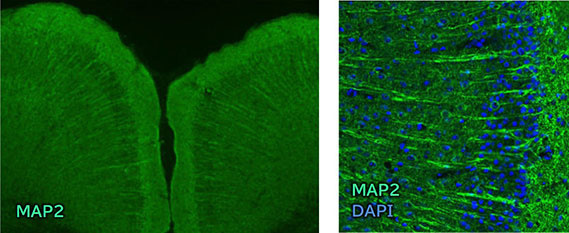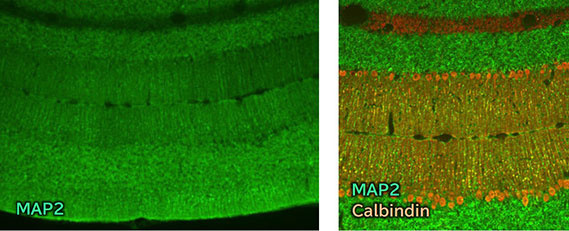Anti MAP2 Antibodies
Microtubule-associated protein 2 (MAP2) is one of the microtubule-binding proteins that binds to microtubules and contributes to their stabilization. It is predominantly expressed in the cell bodies and dendrites of neurons and widely used as a neuronal marker in the field of neuroscience. Moreover, due to its minimal presence in the axons of mature neurons, MAP2 can be used as a dendritic marker for distinguishing dendrites from axons.
What is MAP2?
Microtubule-associated protein 2 (MAP2) is a microtubule-binding protein, abundant in neurons, with its primary function being stabilization of microtubules. Tau, another protein in this family, is well-known for its association with Alzheimer's disease. MAP2 exists in four known isoforms: high molecular weight MAP2a and MAP2b (around 280 kDa), as well as low molecular weight MAP2c and MAP2d (around 70 kDa)1). The N-terminal region of MAP2 contains the projection domain, which includes binding sites for the regulatory subunit of protein kinase A (PKA), whereas the C-terminal region contains the microtubule-binding domain consisting of microtubule-binding repeats. The difference in length of the projection domain mainly accounts for the variation in molecular weight between high- and low-molecular weight MAP2 isoforms.
MAP2 is predominantly expressed in the cell bodies and dendrites of neurons and is widely employed as a neuronal marker in the field of neuroscience. Additionally, MAP2 serves as a dendritic marker for distinguishing dendrites from axons, owing to its low expression in the axons of mature neurons. Apart from neurons, although its expression is weak, MAP2 appears to be present in non-neuronal cells including astrocytes, oligodendrocytes, and testes.
Anti MAP2, Guinea Pig
The “Anti MAP2, Guinea Pig” is a guinea pig polyclonal antibody, raised against MAP22-11). It can be used to perform multiplex immunohistochemistry.
Antibody Information
| Clonality | Polyclonal |
|---|---|
| Antigen | Rat MAP2 (Full-length) |
| Host | Guinea pig |
| Formulation | Antiserum |
| Conjugate | Unconjugated |
| Cross-reactivity | Mouse, Rat |
| Application | Immunohistochemistry (Frozen Section) 1:500-1,500 |
Application Data
Immunohistochemistry

Species: Mouse
Site: Motor cortex
Sample: Frozen section
Antibody concentration: 1:1,500
Data by courtesy of
Dr. Miyata, Department of Applied Biology, Kyoto Institute of Technology

Species: Mouse
Site: Cerebellum
Sample: Frozen section
Antibody concentration: 1:1,500
Data by courtesy of
Dr. Miyata, Department of Applied Biology, Kyoto Institute of Technology
References
- Dehmelt, L. and Halpain, S.: Genome Biol., 6, 204(2005).
The MAP2/Tau family of microtubule-associated proteins - Taniguchi, Y. et al.: Cell Tissue Res., 343, 303(2011).
Localization of plasminogen in mouse hippocampus, cerebral cortex, and hypothalamus - Asai, H., Morita, S. and Miyata, S.: Cell Biochem. Funct., 29(8), 660(2011).
Effect of pleiotrophin on glutamate‐induced neurotoxicity in cultured hippocampal neurons - Mannari, T. et al.: Glia, 61(6), 957(2013).
Astrocytic TRPV1 ion channels detect blood‐borne signals in the sensory circumventricular organs of adult mouse brains - Hourai, A. and Miyata, S.: J. Neurosci. Res., 91(6), 757(2013).
Neurogenesis in the circumventricular organs of adult mouse brains - Morita, S. and Miyata, S.: Cell Biochem. Funct., 31(5), 400(2013).
Synaptic localization of growth‐associated protein 43 in cultured hippocampal neurons during synaptogenesis. - Morita, S. and Miyata, S.: Cell Biochem. Funct., 31(8), 668(2013).
Accessibility of low-molecular-mass molecules to the median eminence and arcuate hypothalamic nucleus of adult mouse - Morita, S. et al.: Cell Tissue Res., 359, 865(2015).
Vascular endothelial growth factor-dependent angiogenesis and dynamic vascular plasticity in the sensory circumventricular organs of adult mouse brain - Furube, E., Morita, M. and Miyata, S.: Cell Tissue Res., 362, 347(2015).
Characterization of neural stem cells and their progeny in the sensory circumventricular organs of adult mouse - Furube, E. et al.: Sci. Rep., 10, 2826(2020).
Neural stem cell phenotype of tanycyte-like ependymal cells in the circumventricular organs and central canal of adult mouse brain - Nambu, Y. et al.: Neurosci. Res., 173, 44(2021).
Effects of leptin on proliferation of astrocyte- and tanycyte-like neural stem cells in the adult mouse medulla oblongata
Product List
- Open All
- Close All
Anti MAP2, Guinea Pig (Polyclonal Antibody)
For research use or further manufacturing use only. Not for use in diagnostic procedures.
Product content may differ from the actual image due to minor specification changes etc.
If the revision of product standards and packaging standards has been made, there is a case where the actual product specifications and images are different.
The prices are list prices in Japan.Please contact your local distributor for your retail price in your region.



